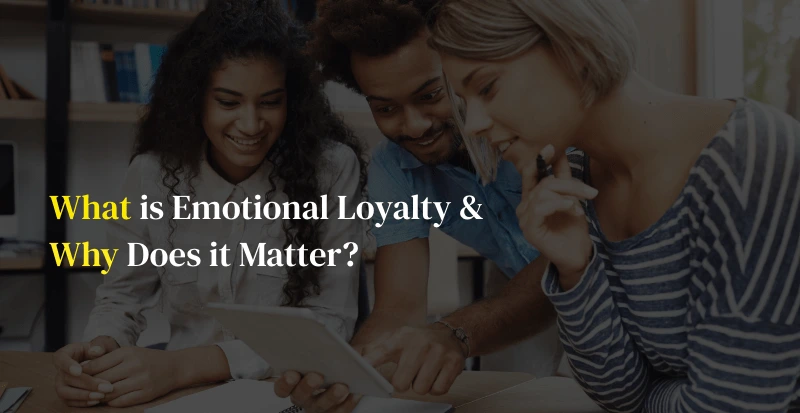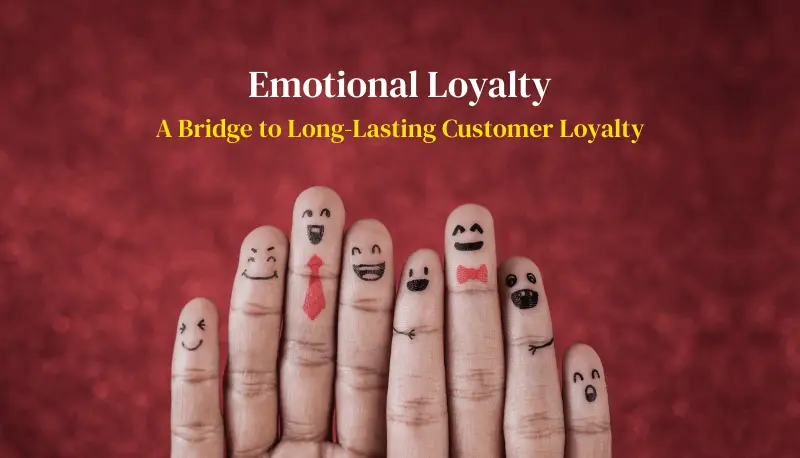Today’s customers are the ultimate surfers, hopping between channels, devices, and sites as they shop. Covid fatigue is affecting virtually everyone. Customers are tired emotionally, psychologically, and physically from the toll the pandemic has taken on daily life. As a result, many customers simply want their shopping experience to be convenient, simple, and satisfying.
Today’s ever-connected customers have multiple choices at any given point. As humans typically do when presented with many choices, they rely on factors like brand experience, convenience, offers, price, and reviews to guide their choices.
With so many choices, how do brands stand out from the competition? The answer lies in emotional loyalty. Research from Forrester concludes that emotion is the biggest driver of loyalty in many industries. A study by Capgemini found that there are significant benefits to nurturing a relationship with emotionally invested customers.
What is Emotional Loyalty?

Emotional loyalty can be defined as a psychological preference and affective attachment, loyalty to a brand is demonstrated in this case by favorable perceptions, opinions, and recommendations. Emotional loyalty is achieved when customers want to advocate for your brand because they are connected with you. The human element in these relationships is real, and customers crave that reciprocity from the brands they love.
Brands that share a deep, emotional connection with their customers tend to have a more holistic understanding of how they fit into their customers’ minds—what those customers need from the brand to make their engagement more fulfilling. A holistic loyalty platform helps brands connect with customers at an emotional level.
Why is Emotional Loyalty Important?
Customers look for honesty, transparency, and authenticity in brand interactions. When they can rely on brands to deliver in a personalized and consistent way that leans into empathy and makes them feel appreciated, they’re more likely to choose you over competitors. Successful brands deliver a value exchange that deepens the connection with their most loyal customers and is purpose-driven, reflecting the values of customers and communities. This cultivates brand loyalists and advocates, future-proofing a brand and carrying it through times of disruption.
Of course, emotional loyalty does not happen on its own. Creating emotional loyalty requires an integrated and dynamic mix of activities and interactions between your brand and customers that drives personalized engagement at each touchpoint. Let’s look at some of the most important factors in nurturing emotional loyalty.
How to Cultivate Emotional Loyalty?

1. Create Unique Experiences
Customers want to be rewarded for their loyalty. From elite rankings to special events and unique experiences, offering one-of-a-kind rewards and customer experiences that make members feel special, valued, and appreciated is essential. Loyalty programs that offer exclusive, one-of-a-kind rewards, such as an invitation to a VIP event, help to make customers feel part of an exclusive community.
Alternatively, offer early access to sales or limited-edition rewards to make customers feel appreciated and build a greater emotional attachment to the brand. Investing in your customer loyalty initiatives to drive an emotional connection will significantly increase customer value and even attract new customers to your brand.
2. Offer Personalization
Customers today desire personalized connections with the brands they patronize. Providing such links and creating memorable experiences is more valuable than the everyday transactional and impersonal interactions that have become commonplace. Doing so can strengthen loyalty and gain an advantage over competitors.
To achieve this, placing your customers at the heart of your brand’s universe is crucial. Personalized customer service plays a pivotal role in achieving this goal. Just as it would be disconcerting if an old friend forgot your name or shared experiences, maintaining the ability for your agents to recognize returning customers instantly is vital for building trust and deepening relationships. Agents should have instant access to past support interactions and the customers’ overall history with your brand and pertinent information.
For instance, in an e-commerce business, when a customer contacts you, your agents should automatically access their order history, prior interactions, shipment details, and tracking numbers. Additionally, ensuring that customers are seamlessly connected to the same agent they previously interacted with further fosters trust and familiarity, which are essential foundations of emotional loyalty.
Utilize Data for Relationship-Building
Creating contextually relevant emotional connections with customers necessitates an emotionally intelligent system that breaks down data silos and integrates information from various touchpoints. When harnessed effectively, data empowers brands to engage existing customers through tailored communications.
Emotional Loyalty Program Illustration
Consider the Starbucks loyalty program, which expertly employs customer data to cultivate relationships. With every dollar spent via the app, customers earn two stars. Push notifications alert customers before their stars expire, along with instructions on how to preserve them. These notifications also deliver spontaneous time-limited discounts, opportunities to sample new menu items, and customized offers that coincide conveniently with lunchtime or the customer’s proximity to a Starbucks store.
All this insight derives from the customer’s prior transactions: their product preferences, visit times, and dining choices. This approach individualizes the bond between Starbucks and its vast loyalty membership and instills a sense of immediacy.
3. Leverage Data to Build Relationships
Building contextually appropriate emotional relationships with customers requires an emotionally intelligent ecosystem that eliminates silos and brings together data from across customer touchpoints. When used properly, data provides brands with the means to engage existing customers with tailored communications directly.
Emotional Loyalty Program Example:
For example, the Starbucks loyalty program uses customer data perfectly to build relationships. For every dollar the customer spends on purchases made through the app, they earn two stars. Customers receive push notifications to let them know their stars are about to expire, with instructions on how to save them. Other push notifications include spontaneous limited-time discounts, invitations to try new menu items for free, and other tailored offers that always seem to come through right around lunchtime or when a customer is in close proximity to a Starbucks.
All this information stems from the customer’s previous transactions: what products they like, what time of day they visit the store, and whether they prefer to dine in or take away. Not only does this personalize the relationship between Starbucks and each of its million-plus loyalty members, but it also encourages a sense of urgency.
4. Surprise and Delight
Brands that can demonstrate value to their customers beyond service and product offerings have the potential to form a deeper connection. One way brands add value and differentiate from the competition is by using surprise and delight tactics to show gratitude to their best customers.
A simple gift, free product, or exclusive promotion is an excellent way of extending thanks to a loyal customer. Through analysis of loyalty program trends and behaviors, brands can identify the best customers to target with elements of surprise and delight.
Examples of Surprise and Delight:
a) Gifts and Free Products: Sending a small, unexpected gift or a complimentary product to a loyal customer can be incredibly impactful. This unexpected act of generosity not only demonstrates gratitude but also makes customers feel valued and special. For instance, a cosmetics company might include a sample of a new product in a loyal customer’s order.
b) Exclusive Promotions: Offering exclusive discounts or promotions to loyal customers not only saves them money but also gives them a sense of exclusivity. This can foster a deeper emotional connection with the brand. An example could be a clothing retailer offering an exclusive sale to their top customers before the general public.
c) Offers: Using data and insights from a customer’s previous interactions and purchases, brands can tailor surprise offers to match individual preferences. For instance, an online bookstore might send a loyal customer a coupon for books in genres they frequently purchase.
Utilizing Data for Effective Surprise and Delight
To execute a successful surprise and delight strategy, brands need to leverage customer data effectively. This involves analyzing customer behavior, purchase history, interaction patterns, and preferences. By identifying your most loyal and engaged customers, you can target them with personalized surprises that resonate.
Benefits of Surprise and Delight
a) Enhanced Emotional Connection: Surprise and delight tactics tap into customers’ emotions, creating a stronger bond between the brand and the customer. The unexpected nature of the gesture can evoke positive feelings and leave a lasting impression.
b) Differentiation: In a competitive market, brands that stand out by going beyond typical transactions can differentiate themselves. The memorable experiences created through surprise and delight tactics set the brand apart from its competitors.
c) Word of Mouth and Advocacy: When customers are pleasantly surprised and delighted, they are more likely to share their experiences with others. Positive word-of-mouth marketing and advocacy can result in new customers and increased brand reputation.
Incorporating the surprise and delight strategy into a comprehensive customer loyalty program requires a thoughtful and strategic approach. Brands should continuously monitor customer feedback and analyze the impact of these surprise elements to ensure they align with customer expectations and aspirations.
Final Thoughts
We all know how powerful emotions can be; organizations that don’t capture, analyze, and understand customer emotions in real time will lag. Emotions can bring people closer to your brand or push them away. To build a genuine relationship with your customers, go beyond your products by fostering emotional loyalty. Focus on understanding your customers’ perspectives, relating to them, and empathizing with them. Ask yourself this question- are you loyal to your customers?


